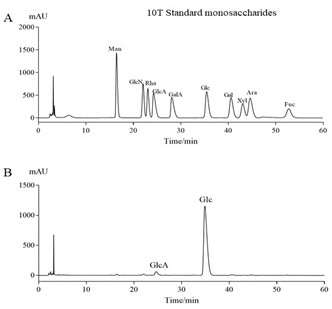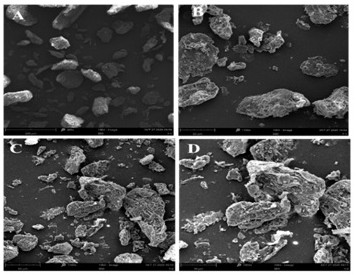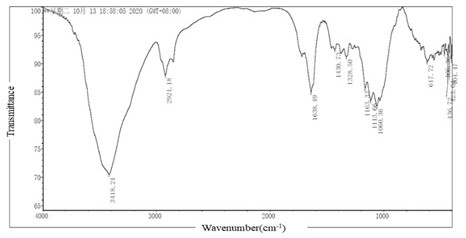Application of insoluble dietary fiber in kelp in preparation of medicine and functional food for improving ulcerative colitis
A technology of soluble dietary fiber and ulcerative colitis, applied in the application field of medicine and functional food, can solve the problems such as the inability of the kelp industry to develop and grow, environmental pollution, waste of resources, etc., to alleviate the histopathological condition, and to have rich sources. , enhance the effect of hydrophilic
- Summary
- Abstract
- Description
- Claims
- Application Information
AI Technical Summary
Problems solved by technology
Method used
Image
Examples
Embodiment 1
[0047] Embodiment 1: Extraction of insoluble dietary fiber
[0048] The extraction method of insoluble dietary fiber among the present invention comprises the following steps:
[0049] (1) Add 5% NaCl solution to the kelp residue according to the ratio of solid to liquid ratio of 1:30, and heat at 90°C for 7 h for decalcification;
[0050] (2) Centrifuge the sample in step (1), collect the precipitate, add an appropriate amount of pure water to wash, and collect the precipitate again;
[0051] (3) Add 5 mol / L NaOH solution to the precipitate in step (2) according to the ratio of solid to liquid ratio of 1:30, adjust the pH to alkaline, and heat at 90°C for 6 h;
[0052](4) Centrifuge the sample in step (3), and collect the precipitate as insoluble dietary fiber (IDF);
[0053] (5) Add NaClO with a volume fraction of 9% to the precipitate in step (4) according to the liquid-to-solid ratio of 12:1, and decolorize the IDF for 67 minutes; the whiteness of IDF after bleaching is ...
Embodiment 2
[0058] Example 2: Identification of the basic structure of kelp insoluble dietary fiber (IDF)
[0059] 1. Determination of the monosaccharide composition of IDF by high performance liquid chromatography
[0060] (1) Accurately weigh 2 mg of IDF prepared in Example 1, add 400 μL of 2 mol / L trifluoroacetic acid (TFA) solution into the ampoule, and degrade under sealed conditions at 105°C for 6 h. After the degradation is completed, add methanol repeatedly to remove excess trifluoroacetic acid, and store the degradation product in a dry environment.
[0061] (2) 100 μL of distilled water fully dissolved IDF degradation products and monosaccharide standard, added 100 μL of 0.3 mol / L NaOH and 120 μL of 0.5 mol / L PMP methanol solution, and bathed in 70°C water bath for 60 min. After cooling to room temperature, 100 μL of 0.3 mol / L HCl solution was added for neutralization reaction, extracted three times with dichloromethane to remove unreacted PMP, and the supernatant was filtered ...
Embodiment 3
[0078] Select C57BL / 6 mice (male), 7-8 weeks old, body weight 25-28g, rearing temperature 20-24°C, humidity 40%-60%, free to drink water and eat during the period. The experimental grouping was as follows: 72 male C57BL / 6 mice were adaptively fed for 7 days and randomly divided into 6 groups according to body weight, 12 in each group, which were normal group (NC), model group (MC), positive drug group (PC), Low, medium and high dose IDF groups (L-IDF, M-IDF, H-IDF). At the end of adaptive feeding, the test substance was gavaged. The mice in each group were gavaged with the test substance every day at 9:00 am for 7 days. On the 8th day, dextran sodium sulfate (DSS) was used to establish the ulcerative colitis model. After the last meal, on the 14th day, the mice were fasted without food and water overnight. The next day, the mice were sacrificed by dislodging the cervical spine after taking blood from the eye socket. Intervention plan See Table 2. During the intervening mode...
PUM
 Login to View More
Login to View More Abstract
Description
Claims
Application Information
 Login to View More
Login to View More - R&D
- Intellectual Property
- Life Sciences
- Materials
- Tech Scout
- Unparalleled Data Quality
- Higher Quality Content
- 60% Fewer Hallucinations
Browse by: Latest US Patents, China's latest patents, Technical Efficacy Thesaurus, Application Domain, Technology Topic, Popular Technical Reports.
© 2025 PatSnap. All rights reserved.Legal|Privacy policy|Modern Slavery Act Transparency Statement|Sitemap|About US| Contact US: help@patsnap.com



